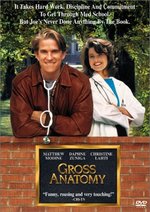Gross Anatomy
posted by Jason Swihart on July 16, 2008
 The Matthew Modine vehicle, Gross Anatomy is a bit of late 80s fluff about a first year medical student who must come to grips with the messy business of practicing medicine. Doctors, it turns out, have to deal with real people, who are not as neat and orderly as Gray's Anatomy (the classic medical text, not the primetime tv show) might portray. During the course of his own gross anatomy education, Modine's character gains some critical real-world knowledge and skills, and then he beds Daphne Zuniga.
The Matthew Modine vehicle, Gross Anatomy is a bit of late 80s fluff about a first year medical student who must come to grips with the messy business of practicing medicine. Doctors, it turns out, have to deal with real people, who are not as neat and orderly as Gray's Anatomy (the classic medical text, not the primetime tv show) might portray. During the course of his own gross anatomy education, Modine's character gains some critical real-world knowledge and skills, and then he beds Daphne Zuniga.
In a classic medical education, gross anatomy is the point at which you start practicing the theory you've learned by dissecting an actual human, and later, budding doctors learn on live patients. But imagine if physicians went straight from coursework into practice, never having dealt with any real patients. In our consulting practice, it often feels like we're stuck back in basic anatomy, where we come no closer to real reality than a textbook.
We meet people all day long who talk about blogging and social media as if they were experts, and boy are they up on the latest terminology. But when we scratch the surface, we discover they they don't actually do any of these activities themselves—they have no idea how the actual tools work and have never struggled personally with the real world complications of making and keeping connections with an audience. It's easy to mouth words like "conversational marketing" when you have no skin in the game, but what does it really mean, how do you do it, and what if no one wants to talk to you?
That's a main reason we maintain side projects like Bike Hugger, Snow Hugger, and Clip-n-Seal. (The other main reason is: they're fun). We don't want to be stuck in a classroom talking theory, we like being in the lab, trying stuff out and seeing what happens. Our laboratories are where we explore boundaries and find out how the risks and rewards play out across different media. E.g.,:
- How bad is it, really, when you make a gaff?
- Can a contests increase your audience over the long term?
- Which of the spam-reduction methods give the greatest return on effort?
- Is there any ROI for a Facebook presence?
- Which comments should you allow and which should you disallow?
We consistently find that our real-world experiences trump any report written by a third party. The experiences of others are interesting and useful, but too many marketing and PR practitioners thinks they can substitute reports for specific experience. It can lead to some dramatic differences of opinion when we're put in a room full of other consultants or when we challenge the wisdom dolled out by other experts. So what are the big lessons we've learned in our laboratories?
- Find something you're interested in and make content about it.
- There's no white paper or acronym for having something interesting to say.
- It's almost never about what platform you're using.
- You never know where you'll get your next "hit," so experimentation is critical.
If you're a doctor, show me your patients. If you're social media practitioner—a pundit, expert, consultant, program manager, marketer, etc.—show me your content. If you're not trying things out and even failing in places where it matters, you don't have the grounding to understand these complex and abstract media.
Comment
other posts tagged:
